On My Film Work
Originally it began with little regular 8 mm cameras, then Super 8 mm, 16 mm, and finally, I owned a complete setup for 16 mm, sound, lighting and even the 35 mm camera package which was used on a number of James Bond films including Thunderball and You Only Live Twice. I have raised and used hundreds of thousands of dollars to make films which were on topics of interest to me.
To view individual pages on the films mentioned below, click on film poster.
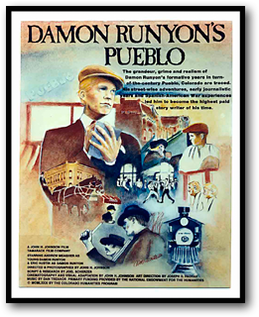
I have always gone back and forth between my photographic work and my film work. I really see very little difference except that, in my photography I like a very purist, direct approach while in filmmaking you manipulate everything to create a totally new reality. I’m always amazed at how that area in front of the camera can become its own reality. My work in one medium tends to enhance the other.
My first films were little drawn or moving object animations. One planned film Continuum involved various brilliantly colored geometric shapes which were to change one into another which I worked on for more than a year, but never put on film. I would use stop motion to animate little battles of film reels in my darkroom. One Christmas I animated a fanciful world of clay. Another film I scripted but never filmed was to be a clay animated piece based on Penderecki's To the Victims of Hiroshima. I also experimented with a number of conceptual films of pure color, form and movement. One entitled Badge used Cream’s song of the same name to which I filmed cut glass at extremely close range with moving colored lights. I loved it and could have easily turned into a conceptual, abstract, non-narrative filmmaker.
While in high school I made films instead of papers. One film equated chess with war. A much longer film which ran 16 minutes entitled Concern 70 had sections on pollution, over population, the Vietnam War, and just the general state of cultural flux of the late 1960s, a segment of which was shown on local TV.
After I began teaching using Super 8 mm, I made an 8 minute film entitled Kayak about a Colorado kayak race and its participants. This film was used to help get the grant to do my first truly professional film Damon Runyon’s Pueblo. Then came Zebulon Pike and the Blue Mountain and finally, a feature film Curse of the Blue Lights with the budgets on each level multiplying many times in amount.
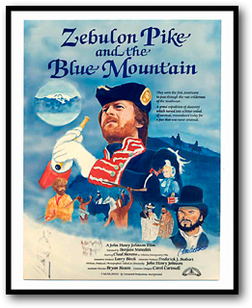
Over the years I have written (or contributed to the writing of) a number of as yet to be produced feature scripts including (working titles): in 1980 I wrote my first feature script The Awakening about the West’s environmental movement (not to be confused with the 2011 film by the same title), Red Wind, a historically based murder mystery; children's fantasy Comic Book Hero; action, adventure western Jake and the Overland Stage and around 1990 when I was living in Burbank, California I wrote La La Land about an independent filmmaker's adventures in Hollywood (again not to be confused with the 2016 musical by the same name, you can’t copyright titles unfortunately). Also, I have developed and researched a number of other historical documentary projects.
Eventually, after Blue Lights success, my family and I moved to Burbank, California for four years. While I was there, the roller coaster which is filmmaking allowed me many unique experiences: to see Steven Spielberg and tour his compound (his personal assistant’s brother in Oklahoma had read an article I’d written for American Cinematographer magazine on the making of Runyon), worked in what was said to be the world’s largest photo lab, Colorhouse, in Burbank (film backgrounds were printed in 6’ wide strips), met James Cameron, Gale Anne Hurd, Richard Edlund, and Alan Daviau among others.
Working at Colorhouse I did photographic work for all the studios, networks, NASA, Revelon, etc. Two of the most interesting jobs I did were for Johnny Carson and Bob Hope. Carson’s son (a landscape photographer) had tragically died when his four wheel drive tumbled off a cliff into the Pacific. I custom printed a number of his family snap shots of his son with their family and Carson personally came by the lab to thank us. Hope’s wife had me print a simple black & white image of him and their two white dogs in their backyard for his birthday present.
One day I read an editorial in Variety by an old sage of the film business about the importance of independent filmmakers to Hollywood. The words could have been mine. I met the author who was producer/lawyer Max Youngstein and we became a good friends.
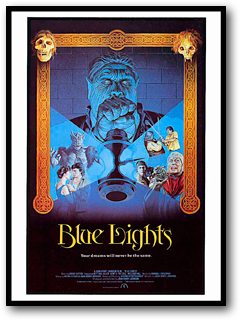
Max was one of the “second five” United Artists moguls who (along with Arthur Krim, Robert Benjamin, Arnold Picker and Bill Heineman) bought out the original five actual “united artists” (D. W. Griffith, Charles Chaplin, Mary Pickford, Douglas Fairbanks, and lawyer William Gibbs McAdoo). Max had mentored such directors as “Stanley” (Kubrick) and “Woody” (Allen) and others. He was instrumental in many significant filmmaker's careers. Max was something of an institution in Hollywood. On his office walls were pictures of himself and various notables, one showed him, Chaplin and the Queen of England! He was full of wonderful stories.
He liked my films, particularly the 360 degree tracking shot I did of Chad Stevens who played Pike in Zebulon Pike and the Blue Mountain which showed the explorer and the terrain moving behind him which made him famous. Max once told me "you have a terribly great talent for making movies and if we keep trying we"ll prove it to the world." It was his belief in me that kept me in California for four years. We tried for a number of years to find something we both wanted to do, but finally, my family and I decided that Colorado was where we’d rather be. Max and I never did find anything we both wanted to do or could fund. Max died shortly after our return to Colorado and my return to teaching.
Filmmaking is very interesting, but you have to rely on too many others and it is so prohibitively expensive to pursue with the projects taking a great deal of time. But I would like, at some point in the future, to make some of my “as yet unfilmed” projects.
All of my films are listed on IMDb and can be found under my name “John Henry Johnson.”
To contact me regarding my film work, a particular film or public presentations of my films email me at: tamarackprod@mac.com.
PODCAST
Thomas Eliot interview with John about the making of Curse of the Blue Lights and filmmaking in general. August 18, 2023. 1 hour 14 minutes. Click here.
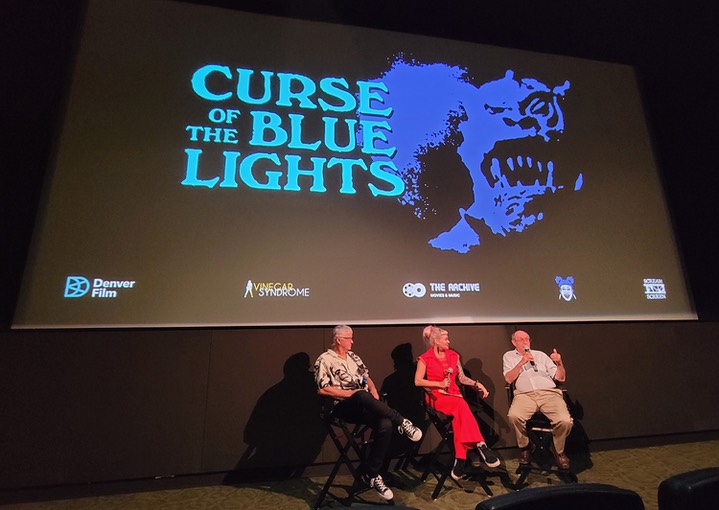
SELECTED FILM SHOWINGS
Denver Film Society, Sie Film Center, Scream Screen benefit presentation for the Denver Film Festival of Curse of the Blue Lights, Theresa Mercado moderating discussion and audience questions with John and Assistant Director Bryan Sisson. September 30, 2023.
Pueblo Rawlings Library, Ryals Grand Events Space, Pueblo: Archaeology and Historic Preservation Month presentation Zebulon Pike and the Blue Mountain showing and discussion, May 3, 2023.
41st Anniversary Benefit Presentation of Damon Runyon’s Pueblo at the Sangre de Cristo Art Center Theater. (A newly restored DVD version was beautifully presented in the same theater where it premiered 4 decades earlier.) The highlight of the “Damon Days" celebration of the famous author. October 5, 2022.
Beulah Historical Society Benefit Presentation, Beulah, Colorado: Curse of the Blue Lights, October 27, 2018; October 31, 2019; October 30, 2021.
Impossible Players Playhouse, "Damon Days" Benefit Presentation, Pueblo: Damon Runyon’s Pueblo, September 18, 2021.
Historic Pueblo, Inc. Damon Runyon Theater, Pueblo: Damon Runyon’s Pueblo, November 18, 2016.
Rocky Mountain PBS stations broadcast premiere of Zebulon Pike and the Blue Mountain, Oct.18, 2016.
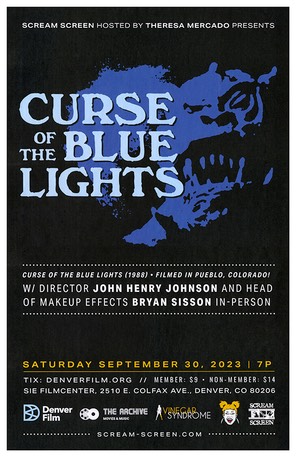
Pueblo Heritage Museum Benefit Presentations, Pueblo: Curse of the Blue Lights, Fall 2012, 2013 & 2014.
San Luis Valley 200th Bicentennial Celebration, Showing Adams State College, Carson auditorium, Alamosa, Colorado: Zebulon Pike and the Blue Mountain, January 27, 2007.
200th Bicentennial Celebration, Sangre de Cristo Art Center Theater, Pueblo: Zebulon Pike and the Blue Mountain, November 23-25, 2006. Exactly 200 years to the day from Pike’s arrival at what is now Pueblo.
200th Bicentennial Celebration Sangre de Cristo Art Center Theater, Pueblo: Zebulon Pike and the Blue Mountain, August 10, 2006.
200th Bicentennial Celebration Custer Historical Society, Westcliffe Theater: Zebulon Pike and the Blue Mountain July 2, 2006.
200th Bicentennial Celebration Zebulon Pike and the Blue Mountain showing Colorado State University Pueblo: June 7, 2006.
Custer Historical Society, Westcliffe Theater, Westcliffe, Colorado: Zebulon Pike and the Blue Mountain, October 24, 1998.
Fremont Historical Society, St. Scholastica Academy Canon City, Colorado: Zebulon Pike and the Blue Mountain, June 7, 1998.
Academy of Science Fiction, Fantasy & Horror Films at the University of Southern California, Norris Cinema Theater, Los Angeles, California: Curse of the Blue Lights, May 23, 1992.
Science Fiction & Fantasy Film Festival, Rome, Italy. Invited feature film: Curse of the Blue Lights, 1990.
Tenth Denver International Film Festival, Colorado Filmmaker's Showcase, Denver: Damon Runyon’s Pueblo, 1987.
"The Film Makers" Rocky Mountain PBS TV series included a Zebulon Pike and the Blue Mountain segment, 1986.
Colorado Historical Society, Denver. Special presentation of Zebulon Pike and the Blue Mountain, 1985. (The Colorado Historical Society recommended the film to the American Association for State and Local History, Oakland, California for its Certificate of Commendation award which it received September 29, 1986 because of its utmost historical accuracy.)
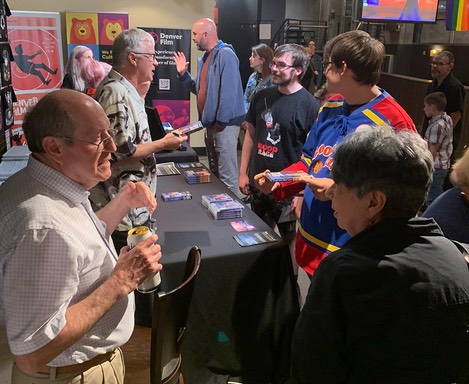
Zebulon Pike and the Blue Mountain premiere Sangre de Cristo Art Center Theater, Nov. 23, 1984. Exactly 178 years to the day of Pike’s arrival at what is now the city of Pueblo.
Colorado PBS stations broadcast premiere of Damon Runyon’s Pueblo, Feb.24, 1982.
Damon Runyon’s Pueblo premiere series Sangre de Cristo Art Center Theater, for cast & crew only Sunday Nov. 1, 1981. Other shows by invitation only Tuesday Nov. 3 (2 shows) and the first public premiere Wednesday Nov. 4, 1981.
Concern 70 segment broadcast from 16 minute Super 8mm film made in high school on over population, pollution, the Vietnam War and the cultural flux of the late 1960s. KOAA-TV 1970.